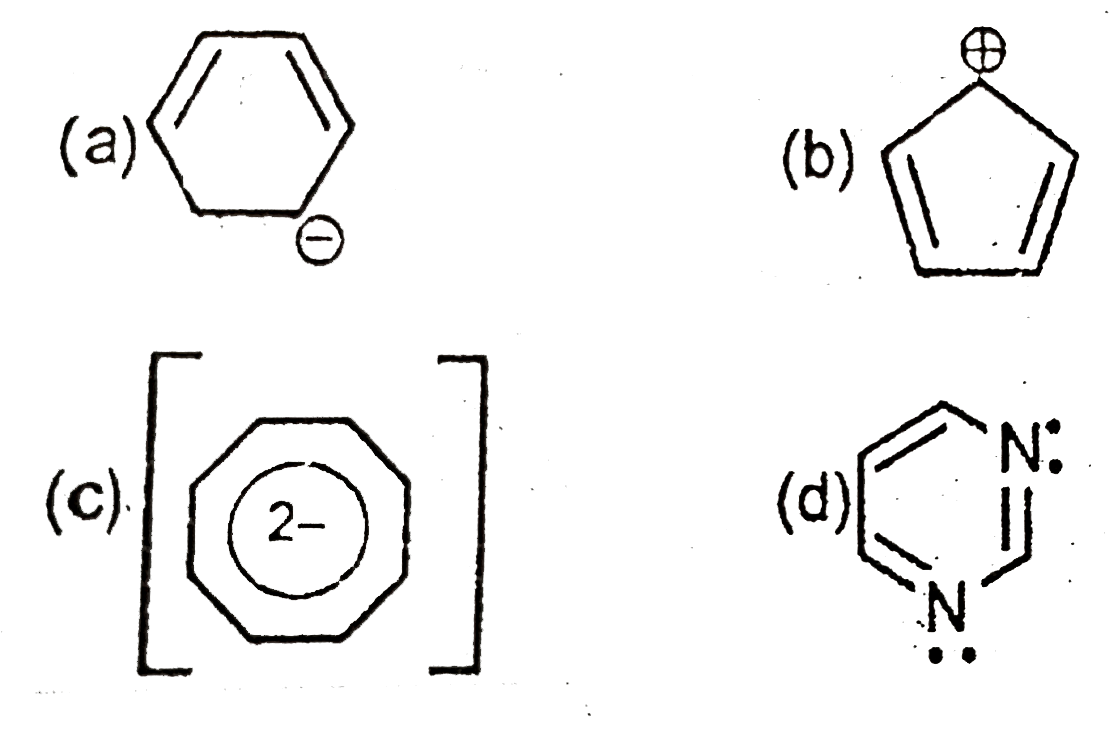Which of the following is an aromatic compound
Phenol
Naphthalene
Pyridine
All
The correct Answer is:D
To determine which of the given compounds is aromatic, we will follow these steps:
Step 1: Understand Huckel's Rule
Aromatic compounds must satisfy Huckel's rule, which states that a compound is aromatic if it has 4n+2 π electrons, where n is a non-negative integer (0, 1, 2, ...).
Step 2: Analyze Each Compound
We will analyze the given compounds one by one to count the number of π electrons.
Compound A: Phenol
1. Structure: Phenol has a benzene ring with a hydroxyl group (-OH).
2. Pi Bonds: The benzene ring has 3 double bonds, contributing 6 π electrons (2 from each double bond).
3. Huckel's Rule:
- Set n=1: 4(1)+2=6 π electrons.
- Conclusion: Phenol is aromatic.
Compound B: Naphthalene
1. Structure: Naphthalene consists of two fused benzene rings.
2. Pi Bonds: There are 5 double bonds, contributing 10 π electrons.
3. Huckel's Rule:
- Set n=2: 4(2)+2=10 π electrons.
- Conclusion: Naphthalene is aromatic.
Compound C: Pyridine
1. Structure: Pyridine is a six-membered ring containing five carbon atoms and one nitrogen atom.
2. Pi Bonds: Pyridine has 3 double bonds, contributing 6 π electrons. The lone pair on nitrogen does not contribute to the π system as it is perpendicular to the ring.
3. Huckel's Rule:
- Set n=1: 4(1)+2=6 π electrons.
- Conclusion: Pyridine is aromatic.
Step 3: Conclusion
Since all three compounds (Phenol, Naphthalene, and Pyridine) satisfy Huckel's rule, they are all aromatic compounds. Therefore, the correct answer is:
Option D: All of the above are aromatic compounds.
---
Aromatic compounds must satisfy Huckel's rule, which states that a compound is aromatic if it has 4n+2 π electrons, where n is a non-negative integer (0, 1, 2, ...).
We will analyze the given compounds one by one to count the number of π electrons.
1. Structure: Phenol has a benzene ring with a hydroxyl group (-OH).
2. Pi Bonds: The benzene ring has 3 double bonds, contributing 6 π electrons (2 from each double bond).
3. Huckel's Rule:
- Set n=1: 4(1)+2=6 π electrons.
- Conclusion: Phenol is aromatic.
1. Structure: Naphthalene consists of two fused benzene rings.
2. Pi Bonds: There are 5 double bonds, contributing 10 π electrons.
3. Huckel's Rule:
- Set n=2: 4(2)+2=10 π electrons.
- Conclusion: Naphthalene is aromatic.
1. Structure: Pyridine is a six-membered ring containing five carbon atoms and one nitrogen atom.
2. Pi Bonds: Pyridine has 3 double bonds, contributing 6 π electrons. The lone pair on nitrogen does not contribute to the π system as it is perpendicular to the ring.
3. Huckel's Rule:
- Set n=1: 4(1)+2=6 π electrons.
- Conclusion: Pyridine is aromatic.
Since all three compounds (Phenol, Naphthalene, and Pyridine) satisfy Huckel's rule, they are all aromatic compounds. Therefore, the correct answer is:
Topper's Solved these Questions
- SOME BASIC PRINCIPLES AND TECHNIQUESBook:NARAYNAChapter:SOME BASIC PRINCIPLES AND TECHNIQUESExercise:EXERCISE - II- C.W (STRUCTURAL ISOMERISM)
Explore 12 Videos
- SOME BASIC PRINCIPLES AND TECHNIQUESBook:NARAYNAChapter:SOME BASIC PRINCIPLES AND TECHNIQUESExercise:EXERCISE - II- C.W (CLEAVAGE OF BOND AND ELECTRONIC DISPLACEMENTS)
Explore 3 Videos
- SOME BASIC PRINCIPLES AND TECHNIQUESBook:NARAYNAChapter:SOME BASIC PRINCIPLES AND TECHNIQUESExercise:EXERCISE - II- C.W (INTRODUCTION, TETRAVALENE OF CARBON, STRUCTURAL REPRESENTATION OF ORGANIC COMPOUNDS:)
Explore 3 Videos
- SOME BASIC CONCEPTS OF CHEMISTRYBook:NARAYNAChapter:SOME BASIC CONCEPTS OF CHEMISTRYExercise:EXERCISE - IV
Explore 43 Videos
- STATES OF MATTERBook:NARAYNAChapter:STATES OF MATTERExercise:A & R TYPE QUESTIONS
Explore 16 Videos
Similar Questions
Knowledge Check
Which of the following is non aromatic compound
APhenolBNaphthaleneCpyridineDCyclo octatetraeneWhich of the following is/are aromatic compounds ?
 Aa&bBb&cCc&dDa&c
Aa&bBb&cCc&dDa&cWhich of the following are aromatic compounds ?
 AI and IIIBI, II and IIICI, II and IVDIII, and IV
AI and IIIBI, II and IIICI, II and IVDIII, and IV
Which one of the following is an aromatic compound?
View SolutionWhich one of the following is an aromatic compound ?
View SolutionWhich one of the following is an aromatic compound ?
View SolutionWhich of the following is a non-aromatic compound ?
View SolutionWhich of the following aromatic compounds will react with KMnO4?
View Solution